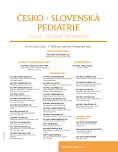The importance of classical cytogenetic examination in clinical paediatric practice: analysis of 384 indications
Authors:
A. Šípek jr. 1; R. Mihalová 1; A. Panczak 1; L. Hrčková 1; M. Janashia 1; A. Baxová 1; J. Zeman 2; T. Honzík 2; M. Kohoutová 1
Authors‘ workplace:
Ústav biologie a lékařské genetiky VFN a UK 1. LF, Prahapřednostka doc. MUDr. M. Kohoutová, CSc.
1; Klinika dětského a dorostového lékařství VFN a UK 1. LF, Prahapřednosta prof. MUDr. J. Zeman, DrSc.
2
Published in:
Čes-slov Pediat 2014; 69 (5): 283-290.
Category:
Original Papers
Overview
Introduction:
Numerical and structural chromosomal abnormalities represent an important group of pathologic conditions in paediatrics. The basic investigation method is the classical cytogenetic examination under the light microscope. The main goal of our study was to analyse the spectrum of paediatric indications for the cytogenetic examination and to analyse the detection rate.
Methods:
Results of standard cytogenetic examinations of paediatric patients (up to the 18th year of age) performed between 2010 and 2012 in the Cytogenetic Laboratory of the Institute of Medical Biology and Genetics of the 1st Faculty of Medicine of Charles University and General University Hospital in Prague were used for our study.
Results:
During the 2010–2012 time period the classical cytogenetic examination was performed in 384 children (204 boys and 180 girls). Pathologic chromosomal abnormality was identified in 35 children (9.1%). The most frequent indication for karyotyping was presence of congenital anomaly (34.6% of cases) followed by psychomotor and/or mental retardation (33.3% of cases). Pathologic karyotype was most often identified in children with clinical suspicion for certain chromosomal syndrome (e.g. Down syndrome) – total 15 cases (3.9% of all examinations). This indication group always had the best detection rate (pathologic karyotypes/all indications) – 26.3%. Presence of isolated congenital anomaly was associated with chromosomal pathology only in 6% of indications and the worst detection rate for pathologic karyotype was in children with short stature (1.3%).
Conclusion:
Classical cytogenetic examination remains in the position of one of the most frequently performed genetic examinations in paediatrics. Cooperation with clinical geneticist is very important for further diagnostics and for decisions on indication of more complex examinations in children with very suspicious phenotype.
Key words:
karyotype, chromosomal abnormalities, genetic syndromes
Sources
1. Gardner RJ McK, Sutherland GR. Chromosome Abnormalities and Genetic Counseling, 3rd ed. Oxford: Oxford University Press, 2004: 1–577.
2. Šípek A, Gregor V, Šípek A jr, et al. Vrozené vady v České republice v období 1994 – 2007. Čes Gynek 2009; 74 (1): 31–44.
3. Gregor V, Šípek A, Horáček J, et al. Prenatální diagnostika vrozených vad v ČR – patnáctileté období. Čes Gynek 2012; 77 (5): 437–444.
4. Šípek A, Gregor V, Horáček J, et al. Incidence vrozených vad u narozených dětí v České republice v období 1994–2010. Neonat Listy 2013; 19 (1): 9–19.
5. Salman M, Jhanwar SC, Ostrer H. Will the new cytogenetics replace the old cytogenetics? Clin Genet 2004; 66 (4): 265–275.
6. ECA General Guidelines and Quality Assurance for Cytogenetics. ECA Newsletter. 2012; 29: 1–19. dostupné online [http://e-c-a.eu/files/downloads/E.C.A._General_Guidelines_Version 2.0.pdf].
7. Schaffer LG, McGowan-Jordan J, Schmid M. ISCN 2013: An International System for Human Cytogenetic Nomenclature. Basel: Karger, 2012: 1–140.
8. Oostdijk W, Grote FK, de Muinck Keizer-Schrama SM, et al. Diagnostic approach in children with short stature. Horm Res 2009; 72 (4): 206–217.
9. ÚZIS ČR. Vrozené vady u narozených 2010. Praha, 2012: 1–168.
10. Gregor V, Šípek A, Šípek A jr, et al. Prenatální diagnostika chromozomálních aberací Česká republika: 1994–2007. Čes Gynek 2009; 74 (1): 44–54.
11. van Karnebeek CD, Jansweijer MC, Leenders AG, et al. Diagnostic investigations in individuals with mental retardation: a systematic literature review of their usefulness. Eur J Hum Genet 2005; 13 (1): 6–25.
12. Hochstenbach R, van Binsbergen E, Engelen J, et al. Array analysis and karyotyping: workflow consequences based on a retrospective study of 36,325 patients with idiopathic developmental delay in the Netherlands. Eur J Med Genet 2009; 52 (4): 161–169.
13. Kannan TP, Zilfalil BA. Cytogenetics: past, present and future. Malays J Med Sci 2009; 16 (2): 4–9.
14. Bejjani BA, Shaffer LG, Ballif BC. The use of microarray technology for cytogenetics. Methods Mol Biol 2010; 632: 125–139.
15. Novelli A, Grati FR, Ballarati L, et al. Microarray application in prenatal diagnosis: a position statement from the cytogenetics working group of the Italian Society of Human Genetics (SIGU). Ultrasound Obstet Gynecol 2012; 39 (4): 384–348.
16. Miller DT, Adam MP, Aradhya S, et al. Consensus statement: chromosomal microarray is a first-tier clinical diagnostic test for individuals with developmental disabilities or congenital anomalies. Am J Hum Genet 2010; 86 (5): 749–764.
17. Manning M, Hudgins L, Professional Practice and Guidelines Committee. Array-based technology and recommendations for utilization in medical genetics practice for detection of chromosomal abnormalities. Genet Med 2010; 12 (11): 742–745.
18. Dolan M. The role of the Giemsa stain in cytogenetics. Biotech Histochem 2011; 86 (2): 94–97.
Labels
Neonatology Paediatrics General practitioner for children and adolescentsArticle was published in
Czech-Slovak Pediatrics

2014 Issue 5
Most read in this issue
- Beta-blockers in the treatment of hemangiomas in childhood
- Ethical concerns involving the newborns at risk
- The role of hepcidin in iron metabolism
- Diagnostic methods in intestinal malrotation disorders
